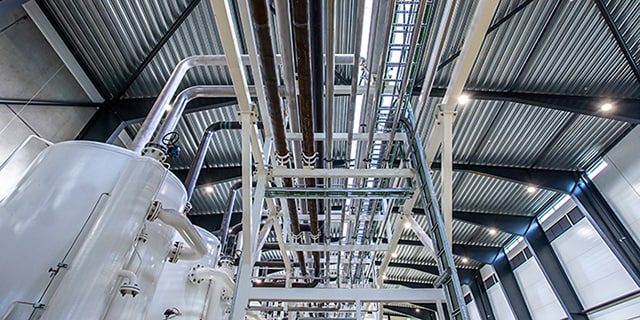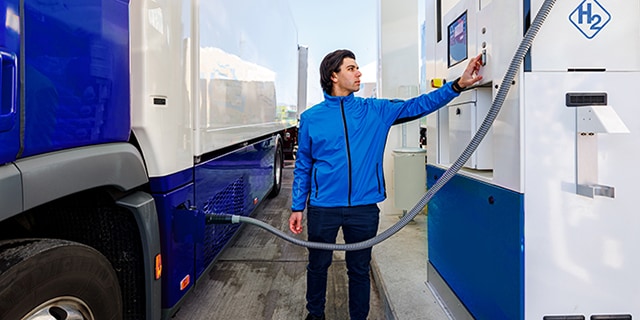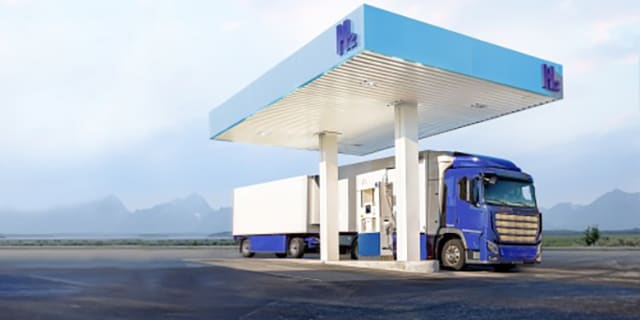The Right Fittings for Green Hydrogen Production Success

How a Green Hydrogen Production OEM Elevated Electrolyzer Reliability with Swagelok
In recent years, great strides have been made in the development of hydrogen as an energy carrier. The major remaining challenges relate to safe, efficient green hydrogen production, processing, and distribution. At Swagelok, we’re proud to be enabling progress in these areas, helping energy companies around the world realize the full potential of hydrogen.
As beneficial as a renewable resource like hydrogen is, there are challenges to managing it. As a highly flammable gas, it must be safely and effectively contained. But the tiny size of hydrogen molecules makes that difficult, as they can escape through even the tiniest of imperfections. And those imperfections can be compounded by another issue, hydrogen embrittlement, which occurs when the molecules attack hard steel materials, creating cracks that can cause the material to fail. Containment and embrittlement issues make it incredibly important to have fittings and valves designed to mitigate these concerns.
These challenges were acutely felt by a leading European producer of alkaline electrolyzers meant to produce “green” hydrogen—hydrogen solely generated using renewable energy. As Swagelok Danmark began working with this customer, the Swagelok Danmark team applied their extensive experience containing and transferring small-molecule liquids and gases under pressure to equip the electrolyzer team for success in hydrogen handling.
“It is a company that was rapidly growing,” said Jesper Skovning, field engineer for Swagelok Danmark. “They went from 50 to 200 people overnight basically. We were able to be a valuable resource to them, there on the ground level, seeing what they were doing, suggesting solutions to avoid leakage and reduce the installation and test time.”
The customer had been using Swagelok® pressure regulators, but not Swagelok® fittings. Yet, when the customer started to have issues with fittings from another supplier, they knew they may need another solution. They decided to run a test of fitting options to determine how to address their problem. Ultimately, the results made it clear how they needed to proceed.

Hydrogen Electrolyzer Fittings Test Showcases Swagelok Reliability
The test involved creating a long stick of straight-to-fitting unions from four participating manufacturers. Hydrogen was applied to this assembly at 40 bar, then it was checked for leakage and left overnight to ensure no pressure drop has occurred. Afterward, the assembly was disassembled, reassembled, and the test was repeated.
“Straight away, from day one,” says Skovning, “they saw the differences between Swagelok and the other manufacturers. They found that non-Swagelok assemblies had leakage after less than 10 remakes. The assemblies featuring Swagelok products were remade more than 20 times without leaks before the nut touched the fitting body and further remakes were no longer possible.”
"They found that non-Swagelok assemblies had leakage after less than 10 remakes. The assemblies featuring Swagelok products were remade more than 20 times without leaks."
Peter Thomsen, regional sales manager for Swagelok Danmark, added, “When I spoke to the engineering manager and he told me the test was complete, he said that Swagelok was ‘the best by far.’ It surprised me that the difference between our products’ performance and competitors’ was so obvious even at a pressure as low as 40 bar.”

Swagelok Fittings Help Boost Electrolyzer Reliability, Reduce Production Time
The results of the test were eye-opening. The company immediately began to transition to Swagelok fittings, and today, all new products from the company include Swagelok components.
“While fittings and valves are not the most technical part of an electrolyzer,” said Skovning, “they are an important part. If you have leaks in those components, even though they’re simple components, it takes time to identify leaks, re-pressurize, fix the leak, and pressurize again. This is costly during production and final testing, but even more costly onsite during maintenance and service of the electrolyzer units.”
They’ve told us they succeeded in reducing production time significantly by changing to Swagelok. It’s helped them see the difference between various products and that they could avoid all the issues they were experiencing by changing to Swagelok,” Skovning continued.
The test has helped expand the relationship between the two companies, leading to Swagelok Danmark providing custom panel assemblies. “They are really open now to learning how else our offerings can help them now that they’ve seen the quality, service, and technical knowledge that they can expect when they work with us.” says Thomsen. “They really trust us as a good partner, and we are pleased to be their preferred supplier.”
Ready to Improve Your Hydrogen Systems?
Connect with your local Swagelok sales and service center to explore how we can support you in handling hydrogen and building out renewable energy infrastructure safely, efficiently, and dependably.
Related Electrolyzer and Hydrogen Handling Articles

Optimize Your Electrolyzers With Fluid System Support
The hydrogen electrolysis process depends on reliable inflow and outflow fluid systems. Learn how you can control costs, enhance safety, and maximize productivity with the right fluid system support.

FAQs: How to Avoid Hydrogen Embrittlement
Selecting the right materials for hydrogen-handling applications is critical to the long-term viability of hydrogen as a fuel source. Learn how to select the right materials and prevent hydrogen embrittlement.

Is Hydrogen a Safe Fuel Source?
Hydrogen has the potential to be a revolutionary clean energy source, but some common myths abound about the fuel’s safety. Get the facts about hydrogen as we explore why it’s a safer fuel source than conventional options.


